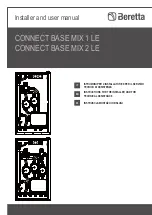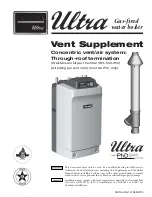
1. All system should be designed so that the static head of the boiler is between a minimum 90mbar
(3ft/w.g.) and a maximum. of 2.7bar (9Oft/w.g.), except for fully pumped systems where the cold feed is
connected into the spare return tapping on the boiler in which case, the static head can be reduced to 1
ft/w.g. (For use in flats and maisonettes).
2. If the head is at or near the minimum 90mbar (3tt/ w.g) extra care should be taken when designing the
system to ensure that pumping over or sucking down at the vent pipe cannot occur.
3. All gravity systems should have a minimum effective height of I.2rn (4ft) between the centre line of the
boiler heat exchanger and the centre line of the domestic hot water cylinder
4. Most types of system controls, such as two-way valves, three-way valves, diverter valves, twin pumps,
zone valves and room cylinder and frost thermostats can be used in conjunction with this boiler.
5. It is recommended that an indirect domestic hot water cylinder is used incorporating a coil type of heat
exchanger, In a fully pumped system, the primary pipework should include a lock shield valve.
6. The circulating pump should be selected with reference to
Figure 2
. The resistance through the boiler
heat exchanger will not exceed 20mbar (8in/w.g.) at a flow rate of 4 gall/mm. for RS40 boilers. For RS50S
boilers the heat exchanger resistance is considerably lower.
7. The resistance through any other type of system control such as a three-way, valve should also be
taken into account when selecting the pump: refer to their manufacturers literature.
8. The circulating pump may be fitted on either the flow or return side of the boiler. If fitted on the flow and
the open vent pipe is located between the boiler and the pump, the risk of air being drawn into the system
is reduced. If fitted on the return, the cold feed pipe should be connected between the pump and the boiler,
but extra care should be taken to ensure that air will not be drawn into the system. Ideally the static head
on the inlet side of the pump should be at least a third of the maximum pump duty.
9. A drain cock(s) should be fitted at the lowest point(s) in the system, so that the whole system can be
drained.
Page 2
Summary of Contents for Flamingo RS40
Page 6: ...FIG 2 PRESSURE LOSS ACROSS BOILER Page 4 DATA SECTION Page 5 ...
Page 14: ...FIG 8 GRAVITY HOT WATER WITH TEMPERATURE CONTROLLED AND PUMPED CENTRAL HEATING ...
Page 18: ...Page 13 ...
Page 29: ...FIG 15 F F D AND THERMOCOUPLE Page 21 Service Section Page 22 FIG 16 SOLENOID VALVE ...
Page 31: ...Back page Page 23 ...




































